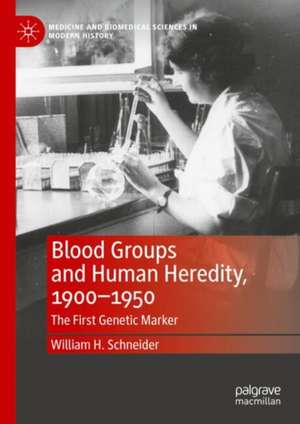Blood Groups and Human Heredity, 1900-1950: The First Genetic Marker
Autor William H. Schneideren Limba Engleză Hardback – 10 noi 2024
Preț: 811.03 lei
Preț vechi: 891.24 lei
-9% Nou
Puncte Express: 1217
Preț estimativ în valută:
155.20€ • 165.95$ • 129.39£
155.20€ • 165.95$ • 129.39£
Carte tipărită la comandă
Livrare economică 14-21 aprilie
Preluare comenzi: 021 569.72.76
Specificații
ISBN-13: 9783031698439
ISBN-10: 3031698436
Pagini: 300
Ilustrații: Approx. 300 p. 50 illus.
Dimensiuni: 155 x 235 mm
Ediția:2025
Editura: Springer Nature Switzerland
Colecția Palgrave Macmillan
Locul publicării:Cham, Switzerland
ISBN-10: 3031698436
Pagini: 300
Ilustrații: Approx. 300 p. 50 illus.
Dimensiuni: 155 x 235 mm
Ediția:2025
Editura: Springer Nature Switzerland
Colecția Palgrave Macmillan
Locul publicării:Cham, Switzerland
Cuprins
Chapter 1. Background and Key Developments of Blood Group Research.- Chapter 2. The Pattern of Research about Blood Groups.- Chapter 3. Blood Group Research in Germany and the Soviet Union.- Chapter 4. Blood Group Research in Great Britain, France, and the United States Between the Wars.- Chapter 5. Blood Group Research in Japan, Italy, and Elsewhere.- Chapter 6. Blood Groups as Markers: Race and Disease.- Chapter 7. Blood Groups and Behavioral Genetics: Crime, Insanity, and Temperament.- Chapter 8. Conclusion: The Legacy of Blood Group Research after 1945.
Notă biografică
William H. Schneider is Professor Emeritus of History and Medical Humanities at Indiana University, USA. Among his numerous historical studies on eugenics, serology and transfusion medicine, and global health history, are recent books on The History of Blood Transfusion in Sub-Saharan Africa and Histories of the HIVs: The Origin of the Multiple AIDS Epidemics.
Textul de pe ultima copertă
This monograph presents a detailed analysis of the beginning and rapid establishment of blood group research in the first half of the twentieth century. The main theme of this book is how blood groups were used as a scientific explanation of differences in race, health, and human behaviour. The discovery of the inheritance of blood groups, and their uneven distribution among various human populations quickly developed into a new field of scientific study in various countries around the world. Almost as quickly, the discoveries were studied as genetic markers of race, disease, and behaviours such as crime, insanity, and temperament. The time scope of coverage is the first half of the twentieth century, beginning with Landsteiner’s discovery of blood groups and ending with the period following the Second World War when the research was picked up again and became part of the revolution in human genetics accelerated by the discovery of the double helix. By this time, blood group genetics had undermined the very concept of race and became the foundation of population genetics. The focus on the formative period of blood group research complements the recent resurgence of interest in the subject by providing in- depth background and a base for further research.
William H. Schneider is Professor Emeritus of History and Medical Humanities at Indiana University, USA. Among his numerous historical studies on eugenics, serology and transfusion medicine, and global health history, are recent books on The History of Blood Transfusion in Sub-Saharan Africa and Histories of the HIVs: The Origin of the Multiple AIDS Epidemics.
William H. Schneider is Professor Emeritus of History and Medical Humanities at Indiana University, USA. Among his numerous historical studies on eugenics, serology and transfusion medicine, and global health history, are recent books on The History of Blood Transfusion in Sub-Saharan Africa and Histories of the HIVs: The Origin of the Multiple AIDS Epidemics.
Caracteristici
Provides a worldwide comparative analysis of the blood group research in its formative period Stimulates further research and offers a basis for deeper analysis Explores the discovery of the inheritance of blood groups
